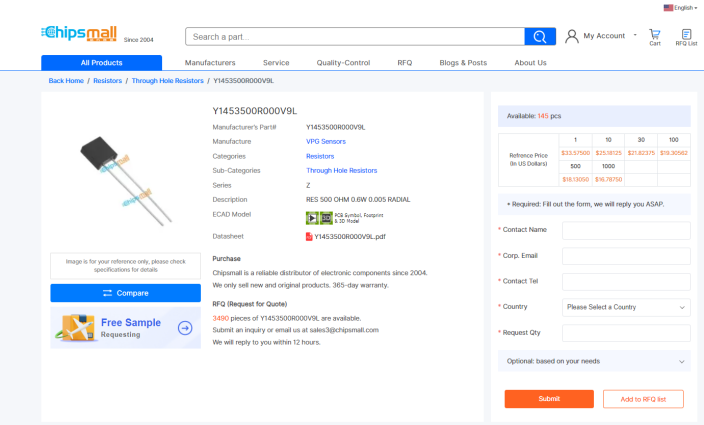OUTLINE:
All About the 500 Ohm Resistor: A Guide for Beginners
 1140
1140500 ohm resistors are one of the most versatile and widely used components in electronic circuits. They come in a variety of sizes and shapes and can be used for a variety of purposes. In this comprehensive guide, we will learn more about 500 Ohm resistor, exploring its purpose and the meaning behind its color code. By the end, you will have a solid understanding of this crucial electronic component.
What is a 500 Ohm Resistor
A 500 Ohm resistor is an electronic component that provides resistance in an electrical circuit.
The property that opposes the flow of electric current is known as resistance. The value 500 Ohms represents the amount of resistance the resistor provides to current flow.

What is the Purpose of the 500 Ohm Resistors
The 500 Ohm resistor serves various purposes in electronic circuits. Here are some common applications:
Voltage division: The resistor helps divide the voltage in a circuit, allowing for specific voltage levels at different points.
Signal conditioning: The resistor adjusts the signal strength or impedance to match the requirements of the circuit, ensuring proper signal transmission.
500 ohm resistors are useful in more than just electrical circuits. They can also be used to guard against damage to sensitive components.
A resistor conducts current when a voltage is applied to it. This current varies in proportion to the voltage and resistance. The lower the current, the higher the resistance.
As a result, a 500 ohm resistor can be used to limit the current flowing through a circuit. This can help to protect delicate components like transistors and diodes. Resistors can also be used to stabilize voltages and prevent voltage spikes.
The Meaning of 500 Ohm Resistor Color Code
Resistors are typically color-coded to indicate their resistance value.
For a 4 band 500 ohm resistor with a tolerance of ±5% (gold), the color codes are:
Green (5)
Black (0)
Brown (1)
Gold (±5%)
Therefore, a 500 ohm resistor with a tolerance of ±5% has a color code of Green-Black-Brown-Gold.

If the 5 band resistor has a tolerance of ±1% (brown), the color code would be:
Green (5)
Black (0)
Black (0)
Brown (1)
Brown (±1%)
Therefore, a 500 ohm resistor with a tolerance of ±1% would have a color code of Green-Black-Black-Brown-Brown.
500 Ohm Resistor Price in 2023 You Can Refer to
The price of a 500 Ohm resistor can vary depending on several factors, including the brand, quality, quantity purchased, and the specific distributor or retailer. To compare prices, let's take the example of the Y1453500R000V9L resistor.
1. Digikey
The unit prices of “Y1453500R000V9L” at Digikey are as follows:
$38.87/1piece
$32.46/10 pieces
$27.37 /100 pieces

2. Mouser
The unit prices of “Y1453500R000V9L” at Mouser are as follows:
$31.39/1piece
$29.38/10 pieces
$22.87 /100 pieces

3. Chipsmall[Cheapest]
The unit prices of “Y1453500R000V9L” at Chipsmall are as follows:
$33.57/1piece
$25.18/10 pieces
$19.30/100 pieces

FAQ
Which is better? 500 ohm resistor or 1K ohm resistor
Whether a 500 ohm resistor or a 1K ohm resistor is "better" depends only on the context and application. The resistance value of a resistor influences how much current may flow through it. A 500 ohm resistor allows more current to pass through than a 1K ohm resistor.
500 ohm resistors are often used in applications that require more current, such as current limiting circuits, voltage dividers, and impedance matching.
While 1K ohm resistors are commonly used in applications that require less current, such as pull-up/pull-down resistors, feedback networks, and timing circuits.
Conclusion
Now, you know what a 500 ohm resistor is, its purpose in electronic circuits, and how to decipher its color code. I believe that you could confidently purchase the suitable 500 ohm resistors from reliable online stores.

Disclaimer: The views and opinions expressed by individual authors or forum participants on this website do not represent the views and opinions of Chipsmall, nor do they represent Chipsmall's official policy.

share this blog to:

